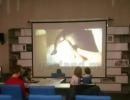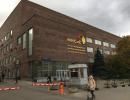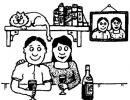Presentation for the lesson Eastern Slavs and their neighbors presentation for a history lesson (6th grade) on the topic. Eastern Slavs and their neighbors. The ancestral home of the Slavs The Proto-Slavs (ancestors of the Slavs) lived at a time of isolation from other Indo-Europeans along the banks of the upper Odra rivers. P
Presentation
Item: Story
Performed: Petrivnaya A.V.

Lesson topic: "Eastern Slavs and their neighbors"

Lesson plan:
- The origin of the Slavic tribes and their ways of settlement.
- Occupations: farming, crafts, trade. The growth of cities.
- Social system and social relations of the Eastern Slavs.
- Neighboring peoples and tribes
- Religion of the Eastern Slavs.

2) Origin and settlement of the Eastern Slavs
3) Concepts: Neolithic revolution, Indo-Europeans
4) Activities of the Eastern Slavs
5) Trade of the Eastern Slavs
6) City and craft
7) Social system of the Eastern Slavs
8) Definition of clan and neighborhood community
9) Relations between the Eastern Slavs and their neighbors
10) Stages of the formation of pagan religious beliefs among the Eastern Slavs
11) The concepts of polytheism and paganism
12) Questions for consolidation
13)Homework

Lesson objectives:
- Consider the ways of settlement and origin of Slavic tribes.
- Characterize the main features of the occupations, social system, life and beliefs of the Eastern Slavs.
- Describe their relations with neighboring tribes and peoples, the general level of socio-economic development.



Origin and settlement of the Eastern Slavs
Indo-Europeans
VIII millennium BC southern shore of the Caspian Sea
Celts, Germanic
and Romanesque peoples
Iranian and Indian
II millennium BC,
interfluve of the Vistula and
peoples of the 2nd millennium
BC, Western
and South Asia
Baltoslavs
2nd millennium BC, southern
shore of the Caspian Sea
V century AD,
Central Europe
resettlement
peoples of the 2nd-6th centuries AD
Western Slavs
V – VIII centuries n. e.,
Center. Europe
East Slavs
Southern Slavs
V – VIII centuries AD,
East Europe
V – VIII centuries AD, Balkan Peninsula.
Glades, Drevlyans, Northerners, Dregovichi,
Polotsk, Krivichi, Radimichi, Vyatichi,
Ilmen Slovenes, Buzhans
(since the 10th century they were called Volynians)

Neolithic revolution – transition during the Neolithic period from a collecting type of economy to a producing one.
Indo-Europeans - one of the largest groups of tribes and languages. The Indo-European group of peoples includes 17 language families, among the peoples belonging to it are the English, Germans, Greeks, French, Armenians, etc.

ACTIVITIES OF THE EASTERN SLAVS (VI-VIII centuries)
East Slavs
Crafts Blacksmithing, pottery,
Beekeeping Collecting honey and
wax wild
Cattle breeding
Cows, horses, sheep, pigs.
Agriculture
Relog Podsek
Forest-steppe Forest
Marten fishery,


RELOGUE, the use of land for arable land until it is depleted with subsequent restoration.
SWIDTH-AND-BURN AGRICULTURE SYSTEM primitive farming system - on lands cleared of forest (cutting down, burning) agricultural plants were grown for 2-3 years, using the natural fertility of the soil.
After its loss, the site was abandoned and a new one was developed.


Trade THE WAY “FROM VARYAGS TO THE GREEKS”
An ancient water trade route from the Baltic to the Black Sea, along which in the 9th-12th centuries. there was trade between Rus' and the North. Europe with Byzantium. From the Baltic metro along the river. Neva, Lake Ladoga, r. Volkhov, lake Ilmen, r. Loot, drag to the river. Zap. Dvina, dragged to the river. Dnieper and further to the Black Sea. On this route there were the largest cities - Novgorod the Great, Kyiv, etc.

Slavic boat
TRADE
In addition to the main route for the Eastern Slavs, “from the Varangians to the Greeks,” there were others. First of all, this is the Volga trade route, which connected Rus' with the countries of the East. The backbone of this route was the Volga and Don. Trade caravans went from the Polyansky lands to the Don, then past the Crimea along the Black and Azov Seas. The further route went down the Volga, through the Khazar possessions to the Caspian Sea and to the countries of the east.



City and craft
Crafts at the beginning of the 9th century reached a high level. Craftsmen could support themselves and their entire family. They began to settle where it was easier to sell their products. This is how the East Slavic cities were born.
Pagan amulet
with bells

Decoration completed
in Scythian animal style



SOCIAL ORGANIZATION OF THE EASTERN SLAVS (VII-VIII centuries)
Veche (people's assembly)
Elder (boyar)
Father (householder)

Tribal community- a group of blood relatives who have common property and run the household together.
Neighborhood Community- a more fragmented association based on the separation of individual small families from the clan.


The relationship of the Eastern Slavs with their neighbors in the 7th-9th centuries.
trade
raids colonization
raids raids
trade
trade
Finno-Ugrians (Chud,
All, Merya)
East Slavs
Byzantine
Turks (Avars,
Bulgars, Khazars)


Russian vigilantes (1,2);
Polovtsian warrior (3)

Stages of the formation of pagans religious beliefs among the Eastern Slavs
FETISHISM-
worship of stones, trees, etc.
ANIMISM -
belief in spirits
TOTEMISM -
veneration of animals
(bear, fox, etc.)
like reincarnated
ANCESTOR CULT -
veneration
churov, churov,
ancestors,
brownies and etc.
PERSONIFICATION
ELEMENTS AND LANDSCAPE-
belief in mermaids, mermen,
goblin, field workers, etc.
POLYDEMONISM -
veneration of various supernatural
creatures, each of whom was “assigned”
a certain sphere of the universe
POLYTHEISM -
the most revered demons begin
To be perceived as elders, in charge, i.e. gods
(Perun, Veles, Svarog, Mokosh, Stribog)


Simargl and Lel

Polytheism- belief in many gods.
Paganism- a religion based on the worship of many gods, idolatry.

Conclusion:
At the end of the 9th century, a state was formed on the lands of the Eastern Slavs. It appeared as a natural result of changes that took place in the internal life of the East Slavic tribes, and was accelerated by external factors - the attack of the Varangians on the northwestern lands and the Khazars on the southern ones. In the Old Russian state, elements of tribal governance were preserved.

Reinforcement task
1. Indicate along the banks of which rivers the Eastern Slavs settled;
A) Danube; B) Dnieper; B) Vistula; D) Pripyat; D) Rod;
2. Indicate who is the owner of the land in ancient Slavic society:
A) Family; B) Gender; B) Community of neighbors;
3. Indicate what type of agriculture the Eastern Slavs used:
A) Shifted; B) Cutting;

- B, G, D.

Homework.
Eastern Slavs Prepared by students of class 6 “B”: Mukhin Evgeniy, Kamzolova Elizaveta, Tereshkina Daria, Zaitseva Alina, Semyonova Yuliana Origin and settlement of the Eastern Slavs Prepared by: Mukhin Evgeniy
Most of Europe and much of Asia have long been inhabited by tribes Indo-Europeans. These tribes were in constant motion, moving around and exploring new territories.
About 4 thousand years ago there was a separation Baltoslavic Indo-European tribes. They settled in Central and Eastern Europe. In the 5th century AD e. the Slavs were divided into Balts and Slavs.
History presentation on the topic "Activities of the Slavs" Completed by: Kamzolova ElizavetaThe main occupation of the Eastern Slavs was agriculture. To plant crops, the land had to be cultivated. First, the trees had to be cut down and burned. Ash was then added to the soil. After the land began to produce a poor harvest, this land was abandoned forever. This system was slash-and-burn.
The Eastern Slavs had another system - shifting land, when the land was depleted it was abandoned for 20 or even 30 years. Once the soil was restored, it could again be used for planting crops. The Slavs also engaged in hunting, cattle breeding, and fishing.
Control
Before resettlement, the Eastern Slavs lived "each in his own family and in his own place." The most important thing was the clan elder; he had great power. After the resettlement, family ties began to disintegrate.
The consanguineous community was replaced by a neighboring community - the rope. individual communities united into tribes, tribes formed unions. Afterwards the power of the ancestral ruler ceased to operate. All the householders in the area gathered for a general council - a meeting. At the meeting, elders were chosen for common affairs. Issues that required the consent of all communities were also resolved at the meeting. The Eastern Slavs did not have military units. If there were military dangers, all men went to fight - the people's militia.
Life and customs of the Eastern Slavs Prepared by: Tereshkina DariaThe main feature of the Slavs was the love of freedom. If guests came to the Slav, the owner tried to please them and put the most delicious treats on the table. The Slavs were brave warriors. They fought until the last drop of blood. Cowardice was the greatest shame
The Slavs lived near rivers, with families in half-dugout houses. The dishes were made of wood. The roof was covered with branches coated with clay. They heated it black, the smoke escaped into a hole in the roof.
Beliefs Prepared by: Alina ZaitsevaThe religion of the Eastern Slavs was paganism - polytheism and idolatry. They represented nature in the form of different gods. For example: Horse is the personified sun, Svarog is the blacksmith god, Svarozhich is the personified fire, etc. The Slavs also believed in evil spirits. For example: Rusalka - the soul of drowned women and children, Mavka - an evil spirit, a mermaid, Yuletide evil spirits - various inhabitants of the other world who penetrate this world during Yuletide, when the gates between worlds are open, Bes - an evil spirit hostile to people, Bereginya - female spirit, the patron of vegetation, living near bodies of water, Fever - a female spirit that inhabits a person and causes illness, Domovoy - the patron spirit of the house, Bannik - the spirit-owner of the bathhouse, Dvorovoy - the spirit-owner of the yard.
To worship their gods, the Slavs performed rituals in groves where idols stood. To appease the gods, they sacrificed animals to them. The Eastern Slavs believed in people who could communicate with the gods and predict the future. These people were called magicians or magicians.
Relations with neighboring peoples and states.The East European Plain was inhabited by other peoples before the appearance of the Eastern Slavs. Powerful eastern tribes subjugated some peoples and forced them to pay tribute. The Slavs borrowed the names of rivers, lakes, and villages from their neighbors. The descendants of the Iranian-speaking Scythian-Sarmatian population had a great influence on the Slavs. Many words came from the Iranian language (axe, boot, hut, steppe, etc.)
In the 8th century, part of the East Slavic tribes was conquered by the Khazars, forcing them to pay tribute.
Their relations with the Byzantine Empire played an important role in the life of the Eastern Slavs. In 860, Constantinople and its surroundings were suddenly attacked by unknown warriors. They sailed from the northern shores of the Black Sea and called themselves Ros or Rus. This is how Byzantium met the Eastern Slavs.




The union was governed by the Council of Antes. Procopius of Caesarea writes: “These tribes, the Slavs and the Antes, are not ruled by one person, but since ancient times they have lived in the rule of people (democracy), and therefore they consider happiness and unhappiness in life to be a common matter.” In particular, in the episode with the Khilbudiy case, the author talks about how “having gathered, as stated above, the Antes forced this man to admit, as they wanted, that he was Khilbudiy, a Roman military leader.” Thus, the union council had enormous power over all the antes. Evenings gathered in special places. For example, near the glades such a place was Kyiv, where there was a pagan temple. The decision made in Kyiv was binding on all “clans” of the glades. The chronicle contains a mention of the “city elders” who made decisions at city meetings near the glades and Drevlyans in the 10th century. Procopius of Caesarea Kyiv

On the origin of the name Rus Russian substantivized adjective; other - russian Russian is formed from an earlier ethnonym of the Eastern Slavs, Rus (the same word was used to call the East Slavic state, sometimes mainly the land of Kiev as opposed to Novgorod and Vladimir-Suzdal). In Byzantine sources, in addition to the stem with -u- (russ-), there is also a stem with -o- Rhos, R(h)osia, which ultimately gives the name Russia. The etymology of the ethnonym "Rus" is unclear; The literature on the issue since the times of Lomonosov and Miller is enormous, but linguists and historians have not come to a convincing solution. In particular, it is unclear whether it was brought to the East Slavic territory by the Varangians (whoever they were by origin) or arose there primordially (and if the latter is true, in which region this occurred). substantivized adjective Russia Lomonosov MillerVarangians

The ethnonym “Rus”: traced back to the Old Icelandic word Róþsmenn or Róþskarlar “oarsmen, sailors”, but the truncation of Róþs is not attested (the Finnish ruotsi Swede is also used in support of the Varangian version); from the Indo-European stem ruksa, russe, russa “blond”, “light”, “white”, “golden” (mainly from the Scandinavian peoples); is considered the forbidden name of the totem animal of the Eastern Slavs - bear (by analogy with Latin ursus, Old Greek αρκτος, however, the correspondence to this name in Slavic would look like * rys);

On behalf of the first prince Rus from the proper Slavic word *rŏud-s-ĭs, related to the words fair-haired (*rŏud-s-ŏs), ore (*rŏudh-ŏs), red-haired (*rūdh-ŏs). That is, according to this version, the self-name of the people of Rus' is associated with hair color (cf. above “light”, “white”, “golden” from ruksa). Finds a typological parallel with the self-name of the Sumerians “black-headed”. from the name of the river Ros in the Kiev region (however, this word had at its root not about and not at, but ъ Ръьь, indirect cases of Rsi, so this etymology is also doubtful). V.I. Dal in his “Explanatory Dictionary of the Great Russian Language” writes: “Rus in the meaning of the world, the world is white.”


Morning, nature awakens, The first rays of dawn In the village of the ancient people They left their reflections. People live here Tall and handsome, - Bright-eyed and strong men, Women, graceful as willows, Children are like strong oak trees.

Eastern Slavs and their neighbors

“..But aren’t good Russians obliged to have more patience, following the rule of state morality, which places respect for ancestors in the dignity of an educated citizen…. We love one thing, we want one thing, we love the Fatherland, we wish it prosperity even more than glory, we wish that the solid foundation of our greatness never changes, that Russia blooms... at least for a long, long time, if there is nothing immortal on earth except the human soul !
N. M. Karamzin

HOUSING
TERRITORY
APPEARANCE
EAST SLAVS
CONTROL
NEIGHBOURS
RELIGION

Sources on the history of Russia 9th – 16th centuries.
Historical source- material, oral or written evidence of the past from which history is studied.
Chronicle - year-by-year record of events that took place
Other written sources on Russian history:
- business documents;
- letters;
- literary works.

2. Origin and settlement of the Eastern Slavs
Indo-Europeans
Western
eastern
Name the tribes of the Western and Southern Slavs known to you.

Settlement of the Eastern Slavs
Eastern Europe: from Lake Ilmen in the north to
Black Sea steppes in the south and from the Carpathian Mountains
in the west to the Volga in the east.
Settlement of the Slavs

EXERCISE:
- Read paragraph 1 pp. 31-35
2. Fill out the table:
Settlement of the Eastern Slavs
Tribe
Place of settlement

3 Lifestyle and activities of the Slavs
Answer the questions:
- What conclusions about the home of the Slavs can be drawn based on these texts?
- What information about the external appearance of the Slavs does the source give us?
- What should Procopius of Caesarea say about the clothing of the Eastern Slavs?
- What character traits did the Slavs have?

- Semi-dugouts with log walls (typical of forest-steppe areas);
- Ground dwellings made of logs (typical of northern forest areas).

East Slavs
(Reconstructions by M. M. Gerasimov)
Woman from the Vyatichi tribe
A man from the Krivichi tribe

Slavic occupations
in the VI-IX centuries.
Hunting
Agriculture
Cattle breeding
cows, horses,
millet, wheat,
beekeeping
sheep, goats,
rye, barley,
oats, peas, beans,
flax, hemp
beekeeping - extraction of honey from wild bees
Slash-
Shifting
fire

EXERCISE:
- Read P. 2. pp. 35 – 36
- Fill out the diagram:
Neighbors of the Eastern Slavs
South and East:
Northeast:

Governance among the Eastern Slavs
- Rope- neighboring community among the ancient Slavs
- Veche- people's assembly
- Civil uprising- the entire male population of the community who fought with the enemies during the attack.
People's Assembly

5. Beliefs of the Eastern Slavs
Paganism – belief in the existence of many gods and spirits (polytheism)
Yarilo
Mokosh
Sun God
deity
fertility
Svarog
god of the universe
Veles
patron
cattle breeding
Perun
god of thunder and

Devilry
Devilry - "lower spirits" divided into useful and dangerous.
Determine who is depicted on the slide and what group of spirits do these creatures belong to?

Slavic idols
Idol – wooden or
stone statue, image of god
Zbruch idol
Slavic gods Svarog and Mokosh

Temple -
pagan place of worship, pagan temple
Temple and idols of the ancient Slavs
Historical, cultural and natural museum-reserve
Tomsk writing

HOUSING:
TERRITORY:
APPEARANCE:
EAST SLAVS
CONTROL:
NEIGHBOURS:
RELIGION:

- Read P. 4
- Learn new terms
- Prepare for the test
Preview:
To use presentation previews, create a Google account and log in to it: https://accounts.google.com
Slide captions:
Eastern Slavs and their neighbors
Objectives: To give an idea of the ancestors of the Slavs, to show the area of settlement of the Eastern Slavs, to introduce the main occupations, life, beliefs, and social structure of the Eastern Slavs. To introduce the neighbors of the Eastern Slavs, to show their relationships.
Homework check: What does the history of the Fatherland study? How do we know about the life of people in ancient and medieval Rus'? Name the chronological framework of the period of history that we will study in 6th grade. What do auxiliary historical disciplines study?
Plan for studying new material: Origin and settlement of the Eastern Slavs. Occupations of the Eastern Slavs. Neighbors of the Eastern Slavs.
Origin and settlement of the Eastern Slavs. - Where were the ancestors of the Russian people from? - Have the Slavs always lived in Eastern Europe or did they come from other lands? Some historians believe that in 1 thousand BC. Slavic tribes lived in Eastern Europe. Other historians consider the Scythian plowmen to be Slavs.
In Eastern Europe there are many rivers with non-Slavic names, for example, the hydronyms Don, Dnieper, Dniester - of Iranian origin, the heritage of the Sarmatians and Scythians. Between the Oka and Volga rivers there are names of Finno-Ugric origin. These are hydronyms that end in “va” - Moscow, Protva, Lysva, Neva. “Wa” means water in Finnish.
The Tale of Bygone Years (12th century), written by Nestor, tells about the arrival of the Slavs to the Dnieper from the Danube through the Carpathians, where in the century there was a strong tribal union of the Dulebs. Modern historians believe that the Slavs’ path to Eastern Europe ran from the southern shores of the Baltic to the shores of Volkhov and Ladoga, to the territory where Novgorod later appeared. The most ancient homeland of the Slavs is Central Europe - the upper reaches of the Danube, Vistula, Oder and Elbe.
Using the text of the chronicle and maps in the atlases “Kievan Rus in the 9th – early 12th centuries.” Fill the table. Name of Slavic tribes Geographical landmarks of the settlement Polyane Northerners Drevlyans Dregovichi Polochans
2. Occupations and social structure of the Slavs The main occupation of the Eastern Slavs was agriculture. They mastered two types of agriculture: 1. Slash-and-burn farming system; 2. Shifting or fallow farming. Working with illustrations in the textbook on p. 9 and in TPO on p. 4.
The Slavs were brave warriors; cowardice was considered a disgrace. Work with the document “Byzantine writer Procopius of Caesarea about the Eastern Slavs” p. 13. - How does the Byzantine writer characterize Slavic warriors?
Beliefs of the Eastern Slavs. The Eastern Slavs were pagans, that is, they worshiped different gods. The Slavs deified the earth, the sun, and water. The most ancient Slavic deities were Rod and Rozhanitsy - the creator and lord of the entire Universe and the patroness of the clan, family, and home. Later, the cult of the sky and the supreme ruler of the world - Svarog, the wind god Stribog, the sun god Yaril, the god of thunder and lightning - Perun arose.
Yuletide fortune telling
Ivan Kupala holiday
Maslenitsa festivities
Working with a document on p. 13. What does the Byzantine author write about the management of Slavic tribes? The Eastern Slavs lived in their clans, i.e. united on the basis of blood relationship. At the head of the clan community was an elder. The clan community was replaced by the neighbor's community - the rope. Veche – community council. The people's militia is the entire male population of the community who fought the enemies.
3. Neighbors of the Eastern Slavs. Eastern Europe, before the appearance of the Slavs on its territory, was inhabited from the Baltic Sea to the Ural Mountains by ancient inhabitants of the forest north: Finno-Ugric tribes - Chud, Merya, Muroma, Ves, Cheremis, Mordovians. The basin of the southern Bug river, the lands in the middle and lower reaches of the Dnieper and its tributaries were inhabited by the descendants of the Iranian-speaking Scythian-Sarmatian population.
Working with the map. Find the neighbors of the Slavic tribes: Khazar Khaganate, Volga Bulgaria, Byzantium, Turkic and Avar Khaganates. Teacher's story.






